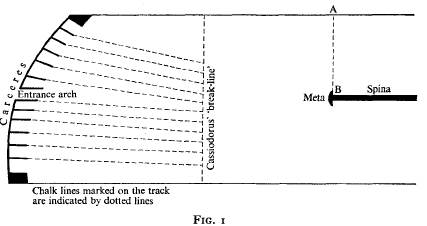No CrossRef data available.
Article contents
The Starting-Gate for Chariots a Postscript
Published online by Cambridge University Press: 05 January 2009
Extract
Pliny the Elder, enumerating the different varieties of chalk, writes, ‘Vilissima qua circum praeducere ad victoriae notam … instituerunt maiores’ (NH xxxv. 47. 199). The Loeb translator gives: ‘The most inferior kind is the one which our ancestors made it the

practice to use for tracing the line indicating victory in circus-races.’ If Pliny meant no more than ‘to mark out the winning-line in the circus’, he seems to have used a curiously clumsy way of expressing it, ‘to mark out the circus at the winning-line’. Elsewhere he uses praeducere more straightforwardly. When he is describing how channels were constructed in mountainous country to bring water to mines, he says that workmen, hanging in cradles from the top of precipices, ‘lineas itineri praeducunt’, ‘mark lines for the route’. We might then have expected him to write, ‘In circo praeducere victoriae notam’, had that been his meaning. If, however, lanes were marked on the track from the carceres to Cassiodorus' ‘break-line’ (Fig. 1), Pliny's expression is justified, ‘to mark out the circus near the winning-line’. The winning-line may have been the same as the break-line, or it may have been level with the meta (A–B, Fig. 1). Pliny's words are equally suitable in either case, as the lanes were at the same end of the circus as the winning-post and near it.
- Type
- Research Article
- Information
- Copyright
- Copyright © The Classical Association 1969
References
1 Greece & Rome xv, no. 2 (1968), 119.Google Scholar




